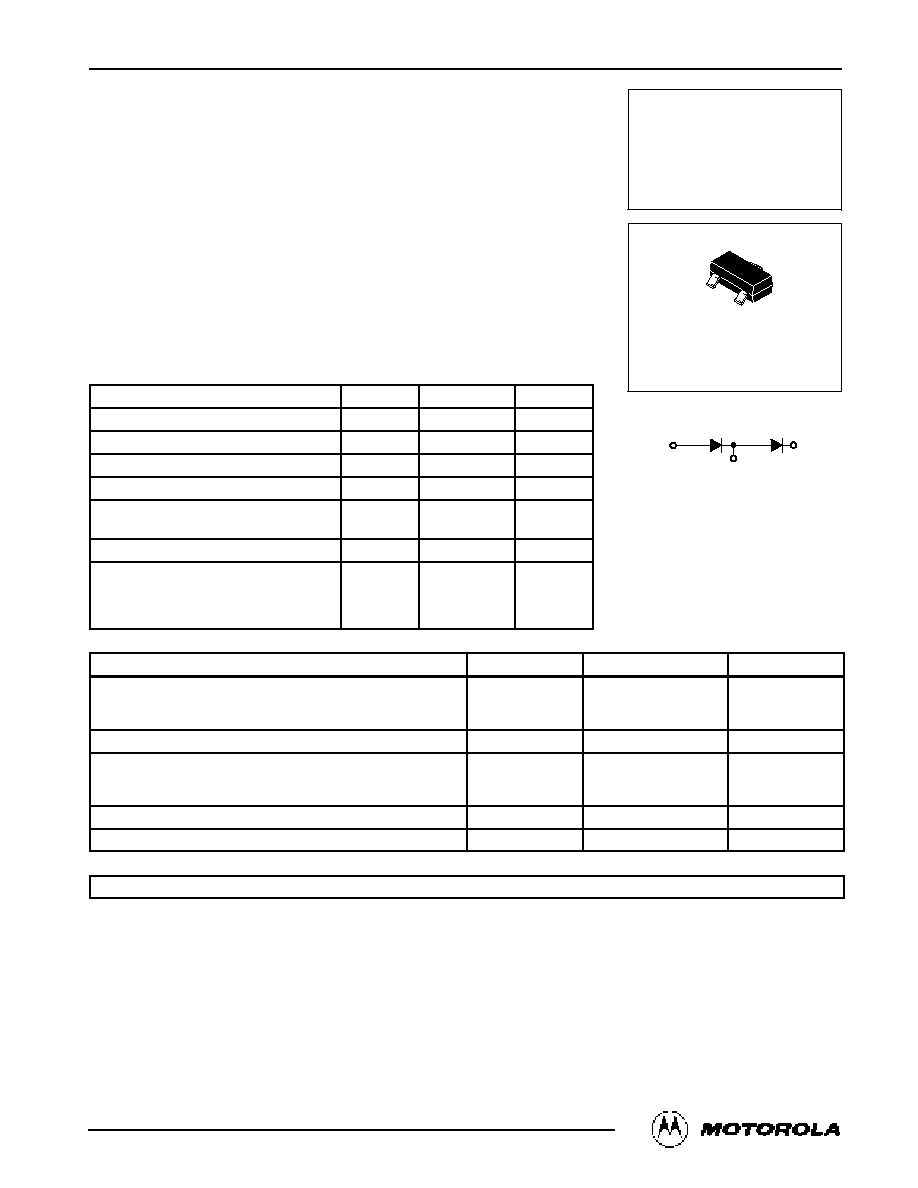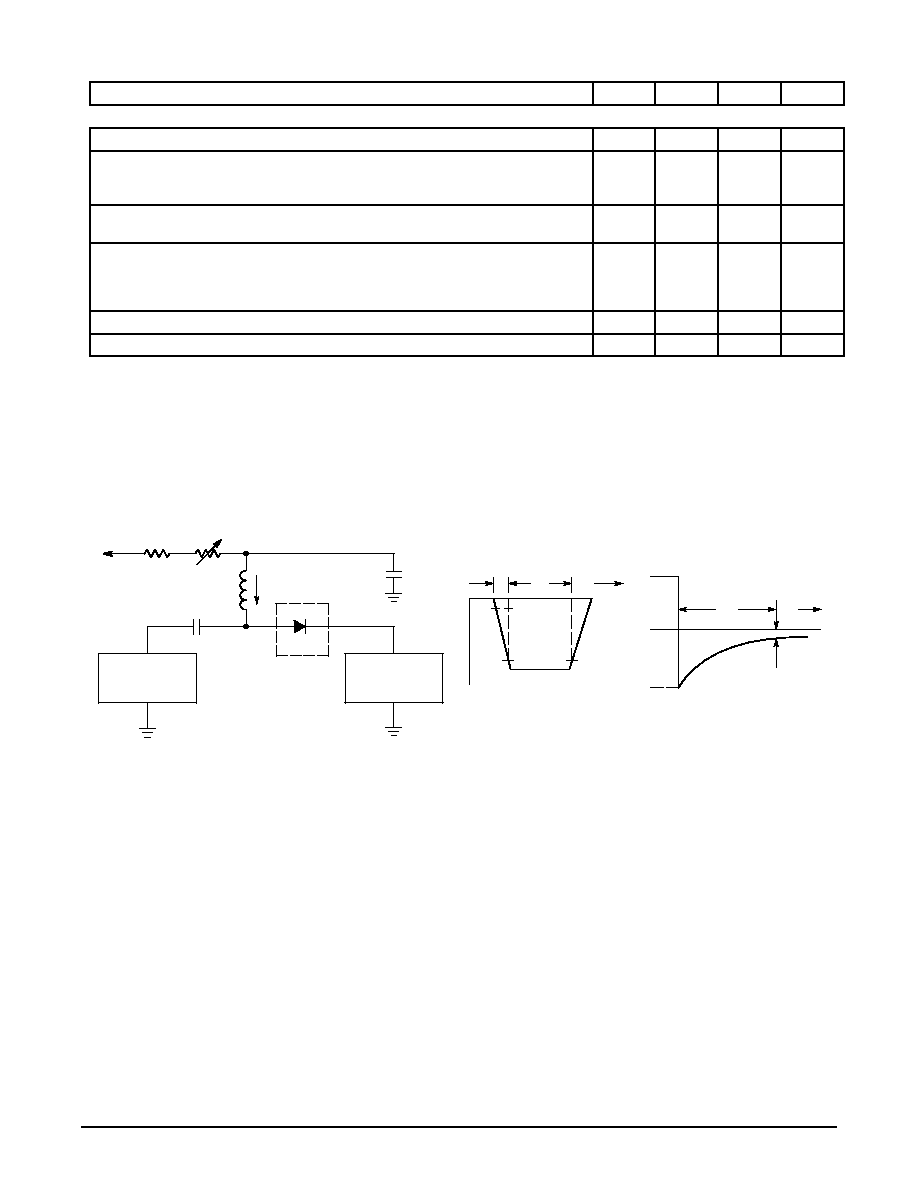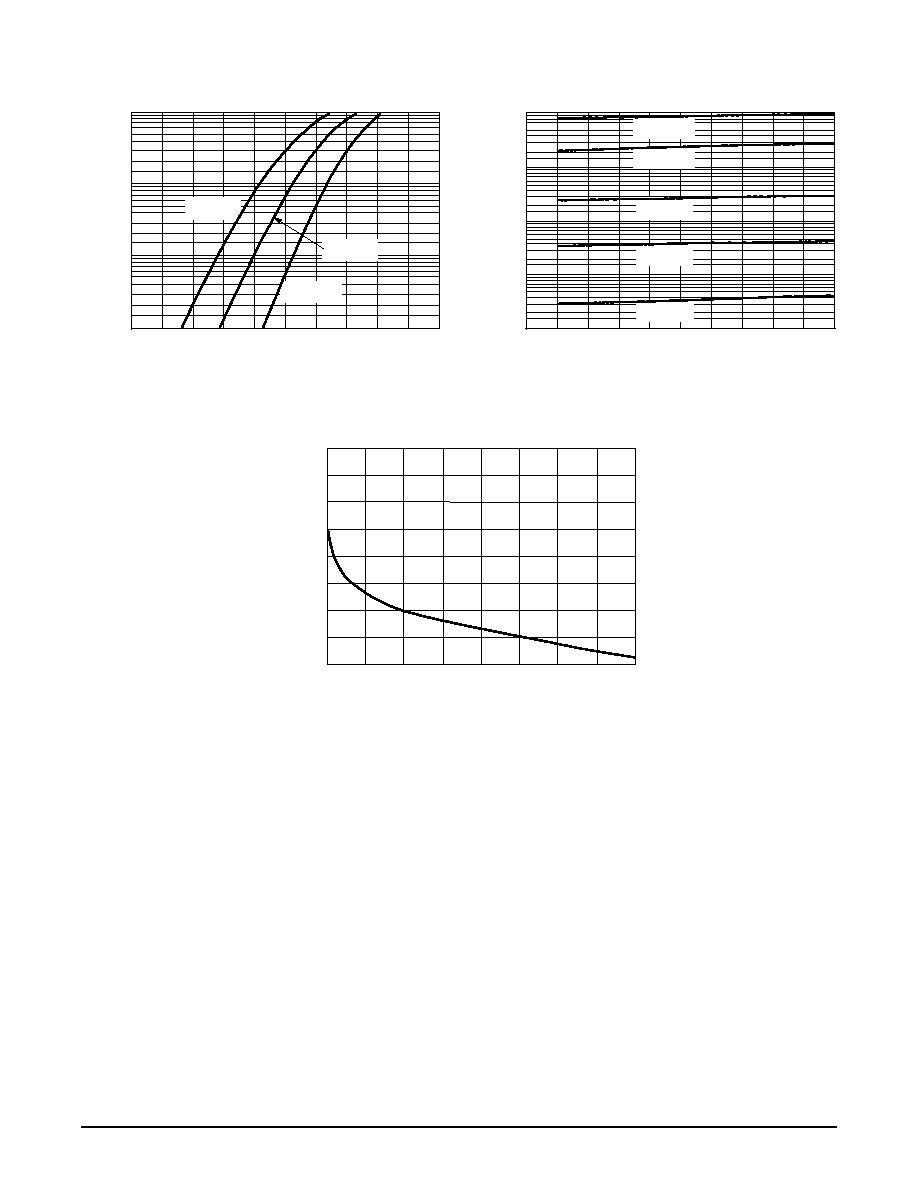 | –≠–ª–µ–∫—Ç—Ä–æ–Ω–Ω—ã–π –∫–æ–º–ø–æ–Ω–µ–Ω—Ç: BAV99LT1 | –°–∫–∞—á–∞—Ç—å:  PDF PDF  ZIP ZIP |

1
Motorola Small≠Signal Transistors, FETs and Diodes Device Data
Dual Series Switching Diode
MAXIMUM RATINGS
(EACH DIODE)
Rating
Symbol
Value
Unit
Reverse Voltage
VR
70
Vdc
Forward Current
IF
215
mAdc
Peak Forward Surge Current
IFM(surge)
500
mAdc
Repetitive Peak Reverse Voltage
VRRM
70
V
Average Rectified Forward Current(1)
(averaged over any 20 ms period)
IF(AV)
715
mA
Repetitive Peak Forward Current
IFRM
450
mA
Non≠Repetitive Peak Forward Current
t = 1.0
m
s
t = 1.0 ms
t = 1.0 A
IFSM
2.0
1.0
0.5
A
THERMAL CHARACTERISTICS
Characteristic
Symbol
Max
Unit
Total Device Dissipation
FR≠5 Board,(1) TA = 25
∞
C
Derate above 25
∞
C
PD
225
1.8
mW
mW/
∞
C
Thermal Resistance Junction to Ambient
R
q
JA
556
∞
C/W
Total Device Dissipation
Alumina Substrate,(2) TA = 25
∞
C
Derate above 25
∞
C
PD
300
2.4
mW
mW/
∞
C
Thermal Resistance Junction to Ambient
R
q
JA
417
∞
C/W
Junction and Storage Temperature
TJ, Tstg
≠ 65 to +150
∞
C
DEVICE MARKING
BAV99LT1 = A7
1. FR≠5 = 1.0 x 0.75 x 0.062 in.
2. Alumina = 0.4 x 0.3 x 0.024 in. 99.5% alumina
Thermal Clad is a registered trademark of the Berquist Company.
Preferred devices are Motorola recommended choices for future use and best overall value.
Order this document
by BAV99LT1/D
MOTOROLA
SEMICONDUCTOR TECHNICAL DATA
BAV99LT1
Motorola Preferred Device
CASE 318 ≠ 08, STYLE 11
SOT≠ 23 (TO ≠ 236AB)
1
2
3
©
Motorola, Inc. 1996
3
CATHODE/ANODE
ANODE
1
CATHODE
2

BAV99LT1
2
Motorola Small≠Signal Transistors, FETs and Diodes Device Data
ELECTRICAL CHARACTERISTICS
(TA = 25
∞
C unless otherwise noted) (Continued) (EACH DIODE)
Characteristic
Symbol
Min
Max
Unit
OFF CHARACTERISTICS
Reverse Breakdown Voltage (I(BR) = 100
µ
A)
V(BR)
70
--
Vdc
Reverse Voltage Leakage Current (VR = 70 Vdc)
(VR = 25 Vdc, TJ = 150
∞
C)
(VR = 70 Vdc, TJ = 150
∞
C)
IR
--
--
--
2.5
30
50
m
Adc
Diode Capacitance
(VR = 0, f = 1.0 MHz)
CD
--
1.5
pF
Forward Voltage
(IF = 1.0 mAdc)
(IF = 10 mAdc)
(IF = 50 mAdc)
(IF = 150 mAdc)
VF
--
--
--
--
715
855
1000
1250
mVdc
Reverse Recovery Time (IF = IR = 10 mAdc, iR(REC) = 1.0 mAdc) (Figure 1) RL = 100
W
trr
--
6.0
ns
Forward Recovery Voltage (IF = 10 mA, tr = 20 ns)
VFR
--
1.75
V
Notes: 1. A 2.0 k
variable resistor adjusted for a Forward Current (IF) of 10 mA.
Notes:
2. Input pulse is adjusted so IR(peak) is equal to 10 mA.
Notes:
3. tp ª trr
+10 V
2 k
820
0.1
µ
F
DUT
VR
100
µ
H
0.1
µ
F
50
OUTPUT
PULSE
GENERATOR
50
INPUT
SAMPLING
OSCILLOSCOPE
tr
tp
t
10%
90%
IF
IR
trr
t
iR(REC) = 1 mA
OUTPUT PULSE
(IF = IR = 10 mA; measured
at iR(REC) = 1 mA)
IF
INPUT SIGNAL
Figure 1. Recovery Time Equivalent Test Circuit

BAV99LT1
3
Motorola Small≠Signal Transistors, FETs and Diodes Device Data
CURVES APPLICABLE TO EACH DIODE
I R
, REVERSE CURRENT
(
A)
µ
100
0.2
0.4
VF, FORWARD VOLTAGE (VOLTS)
0.6
0.8
1.0
1.2
10
1.0
0.1
TA = 85
∞
C
10
0
VR, REVERSE VOLTAGE (VOLTS)
1.0
0.1
0.01
0.001
10
20
30
40
50
0.68
0
VR, REVERSE VOLTAGE (VOLTS)
0.64
0.60
0.56
0.52
C
D
, DIODE CAP
ACIT
ANCE (pF)
2
4
6
8
I F
, FOR
W
ARD CURRENT
(mA)
TA = 25
∞
C
TA = ≠ 40
∞
C
TA = 150
∞
C
TA = 125
∞
C
TA = 85
∞
C
TA = 55
∞
C
TA = 25
∞
C
Figure 2. Forward Voltage
Figure 3. Leakage Current
Figure 4. Capacitance

BAV99LT1
4
Motorola Small≠Signal Transistors, FETs and Diodes Device Data
INFORMATION FOR USING THE SOT≠23 SURFACE MOUNT PACKAGE
MINIMUM RECOMMENDED FOOTPRINT FOR SURFACE MOUNTED APPLICATIONS
Surface mount board layout is a critical portion of the total
design. The footprint for the semiconductor packages must
be the correct size to insure proper solder connection
interface between the board and the package. With the
correct pad geometry, the packages will self align when
subjected to a solder reflow process.
SOT≠23
mm
inches
0.037
0.95
0.037
0.95
0.079
2.0
0.035
0.9
0.031
0.8
SOT≠23 POWER DISSIPATION
The power dissipation of the SOT≠23 is a function of the
drain pad size. This can vary from the minimum pad size for
soldering to a pad size given for maximum power dissipation.
Power dissipation for a surface mount device is determined
by TJ(max), the maximum rated junction temperature of the
die, R
JA, the thermal resistance from the device junction to
ambient, and the operating temperature, TA. Using the
values provided on the data sheet for the SOT≠23 package,
PD can be calculated as follows:
PD =
TJ(max) ≠ TA
R
JA
The values for the equation are found in the maximum
ratings table on the data sheet. Substituting these values into
the equation for an ambient temperature TA of 25
∞
C, one can
calculate the power dissipation of the device which in this
case is 225 milliwatts.
PD =
150
∞
C ≠ 25
∞
C
556
∞
C/W
= 225 milliwatts
The 556
∞
C/W for the SOT≠23 package assumes the use
of the recommended footprint on a glass epoxy printed circuit
board to achieve a power dissipation of 225 milliwatts. There
are other alternatives to achieving higher power dissipation
from the SOT≠23 package. Another alternative would be to
use a ceramic substrate or an aluminum core board such as
Thermal Clad
TM
. Using a board material such as Thermal
Clad, an aluminum core board, the power dissipation can be
doubled using the same footprint.
SOLDERING PRECAUTIONS
The melting temperature of solder is higher than the rated
temperature of the device. When the entire device is heated
to a high temperature, failure to complete soldering within a
short time could result in device failure. Therefore, the
following items should always be observed in order to
minimize the thermal stress to which the devices are
subjected.
∑
Always preheat the device.
∑
The delta temperature between the preheat and
soldering should be 100
∞
C or less.*
∑
When preheating and soldering, the temperature of the
leads and the case must not exceed the maximum
temperature ratings as shown on the data sheet. When
using infrared heating with the reflow soldering method,
the difference shall be a maximum of 10
∞
C.
∑
The soldering temperature and time shall not exceed
260
∞
C for more than 10 seconds.
∑
When shifting from preheating to soldering, the
maximum temperature gradient shall be 5
∞
C or less.
∑
After soldering has been completed, the device should
be allowed to cool naturally for at least three minutes.
Gradual cooling should be used as the use of forced
cooling will increase the temperature gradient and result
in latent failure due to mechanical stress.
∑
Mechanical stress or shock should not be applied during
cooling.
* Soldering a device without preheating can cause excessive
thermal shock and stress which can result in damage to the
device.

BAV99LT1
5
Motorola Small≠Signal Transistors, FETs and Diodes Device Data
PACKAGE DIMENSIONS
D
J
K
L
A
C
B S
H
G
V
3
1
2
DIM
A
MIN
MAX
MIN
MAX
MILLIMETERS
0.1102
0.1197
2.80
3.04
INCHES
B
0.0472
0.0551
1.20
1.40
C
0.0350
0.0440
0.89
1.11
D
0.0150
0.0200
0.37
0.50
G
0.0701
0.0807
1.78
2.04
H
0.0005
0.0040
0.013
0.100
J
0.0034
0.0070
0.085
0.177
K
0.0180
0.0236
0.45
0.60
L
0.0350
0.0401
0.89
1.02
S
0.0830
0.0984
2.10
2.50
V
0.0177
0.0236
0.45
0.60
CASE 318≠08
ISSUE AE
SOT≠23 (TO≠236AB)
STYLE 11:
PIN 1. ANODE
2. CATHODE
3. CATHODE-ANODE
NOTES:
1. DIMENSIONING AND TOLERANCING PER ANSI
Y14.5M, 1982.
2. CONTROLLING DIMENSION: INCH.
3. MAXIMUM LEAD THICKNESS INCLUDES LEAD
FINISH THICKNESS. MINIMUM LEAD THICKNESS
IS THE MINIMUM THICKNESS OF BASE
MATERIAL.

BAV99LT1
6
Motorola Small≠Signal Transistors, FETs and Diodes Device Data
Motorola reserves the right to make changes without further notice to any products herein. Motorola makes no warranty, representation or guarantee regarding
the suitability of its products for any particular purpose, nor does Motorola assume any liability arising out of the application or use of any product or circuit,
and specifically disclaims any and all liability, including without limitation consequential or incidental damages. "Typical" parameters can and do vary in different
applications. All operating parameters, including "Typicals" must be validated for each customer application by customer's technical experts. Motorola does
not convey any license under its patent rights nor the rights of others. Motorola products are not designed, intended, or authorized for use as components in
systems intended for surgical implant into the body, or other applications intended to support or sustain life, or for any other application in which the failure of
the Motorola product could create a situation where personal injury or death may occur. Should Buyer purchase or use Motorola products for any such
unintended or unauthorized application, Buyer shall indemnify and hold Motorola and its officers, employees, subsidiaries, affiliates, and distributors harmless
against all claims, costs, damages, and expenses, and reasonable attorney fees arising out of, directly or indirectly, any claim of personal injury or death
associated with such unintended or unauthorized use, even if such claim alleges that Motorola was negligent regarding the design or manufacture of the part.
Motorola and
are registered trademarks of Motorola, Inc. Motorola, Inc. is an Equal Opportunity/Affirmative Action Employer.
How to reach us:
USA/EUROPE: Motorola Literature Distribution;
JAPAN: Nippon Motorola Ltd.; Tatsumi≠SPD≠JLDC, Toshikatsu Otsuki,
P.O. Box 20912; Phoenix, Arizona 85036. 1≠800≠441≠2447
6F Seibu≠Butsuryu≠Center, 3≠14≠2 Tatsumi Koto≠Ku, Tokyo 135, Japan. 03≠3521≠8315
MFAX: RMFAX0@email.sps.mot.com ≠ TOUCHTONE (602) 244≠6609
HONG KONG: Motorola Semiconductors H.K. Ltd.; 8B Tai Ping Industrial Park,
INTERNET: http://Design≠NET.com
51 Ting Kok Road, Tai Po, N.T., Hong Kong. 852≠26629298
BAV99LT1/D
*BAV99LT1/D*





